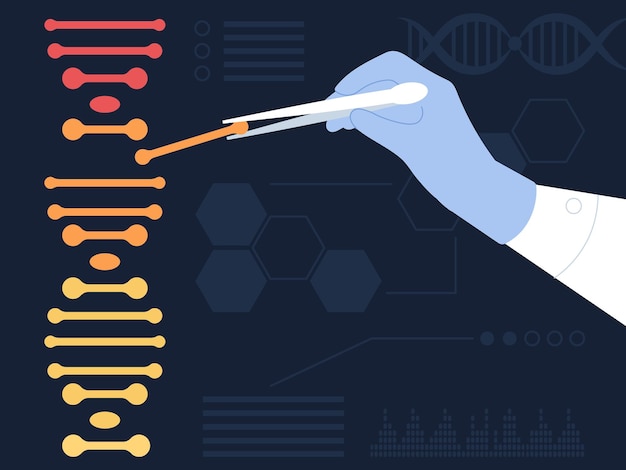Improved CRISPR Technology: A New Modification For More Effective Gene Editing

Table of Contents
Enhanced Specificity of CRISPR-Cas9
The quest for Improved CRISPR Technology has led to significant advancements in enhancing the specificity of CRISPR-Cas9, minimizing off-target effects, and broadening the scope of possible edits. Two key innovations stand out: base editing and prime editing.
Base Editing
Base editing is a refined approach that allows for precise single-base changes without creating double-stranded DNA breaks. This method employs modified Cas9 enzymes fused to deaminase enzymes, which directly convert one base to another.
- How it works: Base editors are targeted to a specific DNA sequence using a gRNA. The deaminase component then chemically modifies a base within the target region, for example, converting cytosine to uracil (C-to-T) or adenine to inosine (A-to-G).
- Limitations: Base editing is limited to the types of base conversions achievable by the fused deaminase and it works best on specific DNA sequences.
- Applications: Base editors, such as adenine base editors (ABEs) and cytosine base editors (CBEs), have shown great promise in correcting single-base mutations responsible for numerous genetic disorders.
Prime Editing
Prime editing represents a significant leap forward in CRISPR technology, offering even greater precision and versatility. It utilizes a reverse transcriptase enzyme fused to a nickase Cas9, enabling a wide array of edits without relying on the cell's DNA repair machinery.
- Advantages over base editing and traditional CRISPR-Cas9: Prime editing can perform all 12 possible base-to-base conversions, insertions, and deletions with significantly improved precision.
- Types of edits: Prime editing can introduce single base changes, small insertions or deletions, and even larger edits, expanding the range of potential genetic corrections.
Improved Delivery Methods for CRISPR Systems
Efficient delivery of CRISPR components into target cells is crucial for successful gene editing. Improved CRISPR Technology involves advancements in both viral and non-viral delivery methods.
Viral Vectors
Viral vectors, such as adeno-associated viruses (AAVs) and lentiviruses, are widely used for delivering CRISPR components due to their efficient gene delivery capabilities.
- Advantages: Viral vectors can efficiently transduce a wide range of cell types.
- Disadvantages: Immunogenicity, limited packaging capacity, and potential for off-target effects remain challenges.
Non-Viral Delivery
Non-viral methods, such as lipid nanoparticles (LNPs) and electroporation, offer alternatives to viral delivery, addressing some of their limitations.
- Advantages: Non-viral methods often have lower immunogenicity and greater payload capacity.
- Disadvantages: Lower transduction efficiency compared to viral methods can be a significant drawback.
Addressing Off-Target Effects of CRISPR
Off-target effects, where CRISPR-Cas9 cuts DNA at unintended sites, remain a critical concern. Improved CRISPR Technology focuses on minimizing these effects through several strategies.
Improved Guide RNA Design
Careful design of gRNAs is paramount to minimizing off-target effects. Computational tools and experimental methods are constantly being refined.
- Computational tools: Algorithms predict potential off-target sites and help select gRNAs with higher specificity.
- Experimental methods: Techniques like deep sequencing allow for precise identification and quantification of off-target cuts.
CRISPR-Cas Systems with Enhanced Fidelity
Researchers are developing and engineering new CRISPR-Cas enzymes with higher specificity and reduced off-target activity.
- Examples: Engineered Cas9 variants, such as high-fidelity Cas9 (e.g., SpCas9-HF1), as well as other Cas enzymes like Cas12a and Cas13a offer improved target specificity.
Applications of Improved CRISPR Technology
The advancements in Improved CRISPR Technology are opening doors to groundbreaking applications across various fields.
Gene Therapy
Improved CRISPR technology holds immense promise for treating a wide range of genetic disorders.
- Examples: Sickle cell anemia, cystic fibrosis, and several other monogenic diseases are prime candidates for CRISPR-based therapies.
Drug Discovery and Development
CRISPR technology is revolutionizing drug discovery and disease modeling, providing powerful tools for identifying drug targets and studying disease mechanisms.
- Applications: CRISPR-based screening methods are facilitating the identification of novel drug targets and the development of personalized medicine approaches.
Conclusion
Improved CRISPR Technology represents a significant advancement in gene editing, offering enhanced specificity, more efficient delivery methods, and reduced off-target effects. The innovations discussed, including base editing, prime editing, improved gRNA design, and high-fidelity Cas enzymes, are transforming the therapeutic potential of CRISPR. These advancements are paving the way for improved gene therapies, innovative drug discovery, and a deeper understanding of complex biological processes. To stay abreast of the latest developments in this rapidly evolving field, explore resources from leading research institutions and scientific journals focusing on Improved CRISPR Technology and its transformative applications.

Featured Posts
-
 Experience Gorillaz House Of Kong 25th Anniversary Exhibition
May 30, 2025
Experience Gorillaz House Of Kong 25th Anniversary Exhibition
May 30, 2025 -
 Palestinian Envoys Emotional Un Plea For Gaza Children
May 30, 2025
Palestinian Envoys Emotional Un Plea For Gaza Children
May 30, 2025 -
 Assemblee Nationale Le Rn Et Lfi Une Bataille Pour Le Controle Du Recit
May 30, 2025
Assemblee Nationale Le Rn Et Lfi Une Bataille Pour Le Controle Du Recit
May 30, 2025 -
 The Truth About Btss Future Addressing Fan Questions About Disbandment And Jungkook In 2024
May 30, 2025
The Truth About Btss Future Addressing Fan Questions About Disbandment And Jungkook In 2024
May 30, 2025 -
 Finding Gorillaz Tickets For Full Album Performances In London
May 30, 2025
Finding Gorillaz Tickets For Full Album Performances In London
May 30, 2025
Latest Posts
-
 Griekspoor Stuns Zverev In Indian Wells Second Round
May 31, 2025
Griekspoor Stuns Zverev In Indian Wells Second Round
May 31, 2025 -
 Griekspoor Pulls Off Major Upset Against Zverev At Indian Wells
May 31, 2025
Griekspoor Pulls Off Major Upset Against Zverev At Indian Wells
May 31, 2025 -
 Zverev Loses To Griekspoor In Indian Wells Shock
May 31, 2025
Zverev Loses To Griekspoor In Indian Wells Shock
May 31, 2025 -
 Zverevs Road To The Munich Semifinals A Comeback Story
May 31, 2025
Zverevs Road To The Munich Semifinals A Comeback Story
May 31, 2025 -
 Tallon Griekspoor Defeats Alexander Zverev At Indian Wells
May 31, 2025
Tallon Griekspoor Defeats Alexander Zverev At Indian Wells
May 31, 2025
